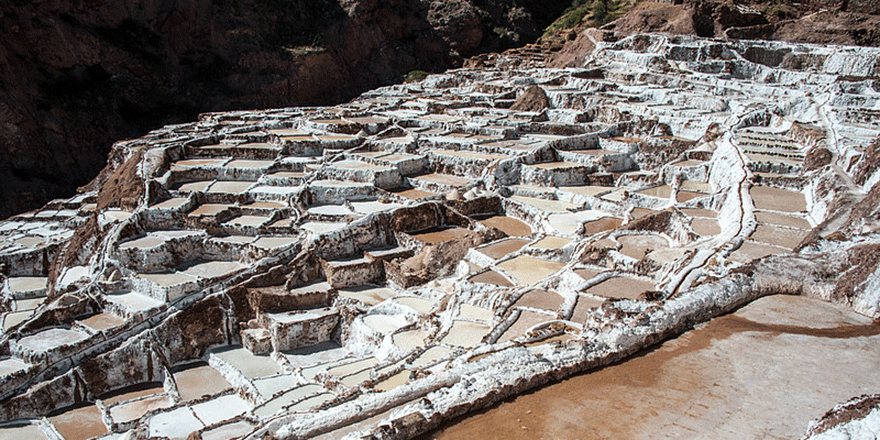Himalayan rock salt is well-known. However, few people are familiar with the other big source of non-sea salt in the world: Sal de Maras (salt from Maras). The pink salt, harvested in the Peruvian Andes, is increasingly appreciated in Peru as well as by its foreign visitors. Add it to your shopping list when visiting the Sacred Valley and you’ll have some original (and sought-after) gifts when you get home!
Las Salineras
Some 45 kilometers north of Cusco, at almost 3400 meters altitude, lies a canyon with an eye-catching terrace with more than 4,000 interlocking salt evaporation ponds (pozos), called Las Salineras. About half of the shallow pools date from Inca times and they’re run by some 380 families that are united in cooperatives.
From a hot spring, water is led through a maze of channels that meander among the pools, which are closed off with a piece of cloth or plastic when they’re full. The ponds are filled with grayish/brown water that needs about a month to evaporate. The result is white pools that glisten like snow in the sun. When the white ponds are ready to be harvested, the salt crystals are scraped off.
This sounds simpler than it is as the salt is harvested in three distinct layers:
– Flor de sal, literally ‘flower of salt’ (or better known as fleur de sel), is the top layer, the fine culinary salt that is the most expensive. It’s gourmet salt, not used for cooking but to be added as the finishing touch to your dish.
– Sal rosada is the pale pink, thicker salt that is prime quality salt for cooking and barbecuing.
– The third layer isn’t edible. You can use this so-called sal de baño for medicinal baths, for example to relax your muscles. According to the local people sal de baño has curative properties. [pagebreak]
Variations of Sal de Maras
Sal de Maras contains calcium, iron (hence the light pink color), zinc, magnesium, and other micronutrients. Enjoy it in pasta, with meat, or add it to salad dressings.
As the salt is becoming more popular, local production companies have expanded their product line by combining the salt with other flavors:
– Salt mixed with green herbs, for example rosemary or oregano.
– Salt with herbs and chili pepper (add it to your salad, chicken or fish).
– Salt mixed with garlic, pepper, and cumin to marinade your meat or add to your stew.
– Salt with a local herb called huacatay, which is recommended for your barbecue meat, and fish with rice.
Or look for unique products such as potato chips or chocolate with Sal de Maras.
Where to Buy It
You can visit Salinas de Maras on a day trip from Cusco and watch the salt production process. At the entrance are souvenir shops selling the salt as well as packages of salt mixed with herbs. Another option is to search for it on Cusco’s markets. In bigger supermarkets throughout Peru you can buy boxes of Sal de Maras as well.


![Making Mealtime Matter with La Familia: Easy Sofrito [Video]](https://thelatinkitchen.com/wp-content/uploads/2015/10/sofrito-shutterstock__0-500x383.jpg)
![Easy Latin Smoothies: Goji Berry Smoothie [Video]](https://thelatinkitchen.com/wp-content/uploads/2015/12/goji_berry-shutterstock_-500x383.jpg)
















![Fun and Fast Recipes: Fiesta Cabbage Salad [Video]](https://thelatinkitchen.com/wp-content/uploads/2015/11/fiesta_cabbage_slaw-shutterstock_-500x383.jpg)









